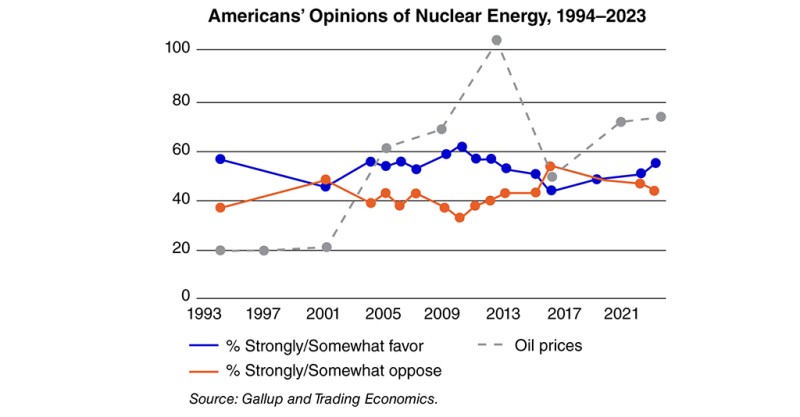Support for nuclear energy in the US is at its highest level in a decade, with 55% of Americans supporting it as a source of electricity. A Gallup poll conducted in March found 25% strongly favor, 30% somewhat favor, while 22% each strongly or somewhat oppose its usage.
The report noted that oil prices have generally affected Americans’ responses since the survey was begun in 1994: high oil prices trended with more openness to nuclear energy, low oil prices trended with less favor.

As of May, there were 436 nuclear power reactors in operation (connected to the grid) worldwide, providing about 10% of the world’s electricity. The countries with the most reactors are the US (93), France (56), and China (55). The largest reactors under construction were in the UK (gross electricity generation capacity of 1,720 MW). The largest-capacity nuclear reactors under construction worldwide were in China, with a total capacity of almost 22 GW (Statistica, May 2023).
Projections for the potential growth of nuclear power in the next decades increased for the second consecutive year in the International Atomic Energy Agency’s 2022 outlook to 2050. Its high case scenario forecast for world nuclear generating capacity more than doubled to 873 GW net electrical (GWe) by 2050, compared with current levels of around 390 GWe, an increase of 81 GWe forecast in 2021. In the low case scenario, generating capacity remains flat.
“We are at a defining moment in the world’s transition to a more secure, stable, and affordable energy future,” IAEA Director General Rafael Mariano Grossi said. “Driven by the impacts of climate change and the energy crisis, governments are reconsidering their portfolios in favor of nuclear power. But for the high case scenario to be achieved, a number of challenges need to be addressed, including regulatory and industrial harmonization and progress in high-level waste disposal.”
The IAEA said the use of nuclear power has avoided about 70 gigatonnes of CO2 emissions over the past 50 years. Almost half of the CO2 emission reductions needed to reach net zero in 2050 will need to come from technologies that are currently under development but are not yet on the market. IAEA said accelerating the pace of innovation and demonstration of advanced nuclear reactors including small modular reactors (SMRs) is required if nuclear is to play a role in decarbonization beyond electricity by providing low-carbon heat or hydrogen to the industrial and transport sectors.
Although the Biden administration has included nuclear energy as a key component in its clean energy plan, support for nuclear energy has historically been tenuous. In the evaluation of the risks vs. benefits of nuclear energy, the risks weigh heavily in the balance, partly because when nuclear power reactors failed, they failed dramatically. Fukushima, Chernobyl, Three Mile Island. While estimates of the number of directly related deaths or subsequent deaths resulting from radiation exposure via the accident or fallout are debated and vary widely, the association of fatalities with nuclear power reactor accidents/disasters is an immediately identified risk.
Concerns about the risk of weapons proliferation, core meltdowns, and disposal of spent radioactive fuel are real and will need to be addressed transparently and convincingly by governments and regulators to gain wider public approval worldwide.
Increasing nuclear generating capacity is not a quick fix. The complexity of the massive project, scale of investment, and long lead times are additional drawbacks. For comparison, a “typical” nuclear power plant requires 5 years (or more) to construct; natural gas-fired plants are frequently built in about 2 years.
The United Nations (UN) estimates that the world’s population will grow from 7.8 billion in 2020 to around 8.5 billion in 2030 and 9.7 billion by 2050. Urbanization, which currently adds a city the size of Shanghai to the world’s urban population about every 4 months, is expected to result in approximately two-thirds of the world’s people living in urban areas by 2050 (up from about 55% now).
The number of people without access to electricity has fallen substantially and is now below 1 billion, according to the UN. However, 733 million people, just over 9% of the world’s population, live without access.
The challenge of meeting the rapidly growing energy demand, while reducing emissions, is considerable and highlights the needs for an energy mix which includes hydrocarbon, renewable, nuclear, and emerging and developing energy sources such as hydrogen.


